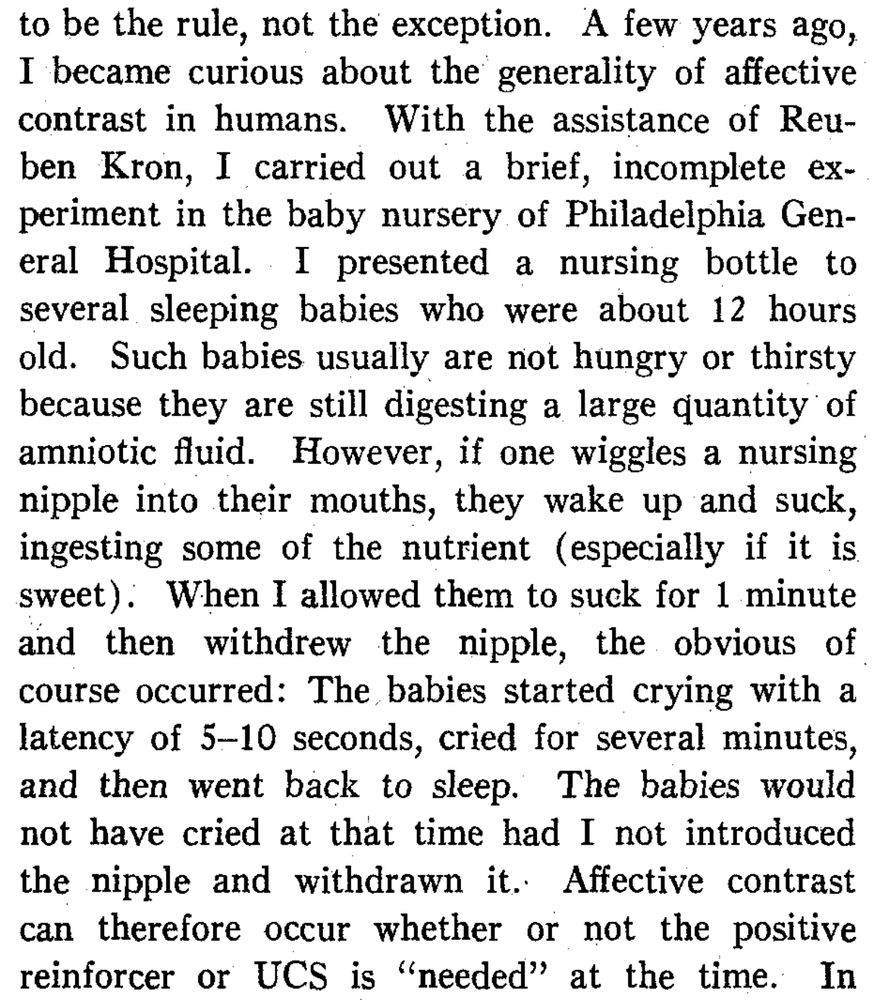Sam Gershman
@gershbrain.bsky.social
Professor, Department of Psychology and Center for Brain Science, Harvard University
https://gershmanlab.com/
https://gershmanlab.com/
Gonna wear this to the next faculty meeting to see if they think I’m Steve Pinker.

October 31, 2025 at 9:38 PM
Gonna wear this to the next faculty meeting to see if they think I’m Steve Pinker.
Really interesting work by Bakhurin and colleagues challenging the reward prediction error hypothesis of dopamine:
www.nature.com/articles/s41...
I love this figure which both echoes and undermines the famous figure from Schultz et al. (1997).
www.nature.com/articles/s41...
I love this figure which both echoes and undermines the famous figure from Schultz et al. (1997).

October 14, 2025 at 11:05 AM
Really interesting work by Bakhurin and colleagues challenging the reward prediction error hypothesis of dopamine:
www.nature.com/articles/s41...
I love this figure which both echoes and undermines the famous figure from Schultz et al. (1997).
www.nature.com/articles/s41...
I love this figure which both echoes and undermines the famous figure from Schultz et al. (1997).
I don't think so, because this implies that if you hold T fixed to a small value and reduce I sufficiently, then you should get faster learning, but in fact this slows learning (i.e., the effect of I is typically monotonic). Ths figure is also from Rescorla's 1988 paper, using Gibbon's data.

October 10, 2025 at 11:59 AM
I don't think so, because this implies that if you hold T fixed to a small value and reduce I sufficiently, then you should get faster learning, but in fact this slows learning (i.e., the effect of I is typically monotonic). Ths figure is also from Rescorla's 1988 paper, using Gibbon's data.
There's another, often less appreciated violation of contiguity, which was nicely documented in this figure from Rescorla (1988). For very short interstimulus intervals, the conditioned response and learning speed *increase* with the interval. This is an anti-contiguity effect!

October 10, 2025 at 11:17 AM
There's another, often less appreciated violation of contiguity, which was nicely documented in this figure from Rescorla (1988). For very short interstimulus intervals, the conditioned response and learning speed *increase* with the interval. This is an anti-contiguity effect!
This is a great idea except for the fact that it's wrong. You can obtain the same learning speed across dramatically different interstimulus intervals (T) as long as the intertrial interval (I) is kept in a fixed ratio with the interstimulus interval (Gallistel & Gibbon, 2000).

October 10, 2025 at 11:17 AM
This is a great idea except for the fact that it's wrong. You can obtain the same learning speed across dramatically different interstimulus intervals (T) as long as the intertrial interval (I) is kept in a fixed ratio with the interstimulus interval (Gallistel & Gibbon, 2000).
And today in the @nytimes.com...
I suggest that papers stop "suggesting a link" so that reporters stop suggesting that papers are suggesting to readers that there might be a causal relationship. They could alternatively suggest that correlations are sometimes caused by latent variables.
I suggest that papers stop "suggesting a link" so that reporters stop suggesting that papers are suggesting to readers that there might be a causal relationship. They could alternatively suggest that correlations are sometimes caused by latent variables.

September 24, 2025 at 1:17 PM
And today in the @nytimes.com...
I suggest that papers stop "suggesting a link" so that reporters stop suggesting that papers are suggesting to readers that there might be a causal relationship. They could alternatively suggest that correlations are sometimes caused by latent variables.
I suggest that papers stop "suggesting a link" so that reporters stop suggesting that papers are suggesting to readers that there might be a causal relationship. They could alternatively suggest that correlations are sometimes caused by latent variables.
My favorite ending of any paper I've written.

September 23, 2025 at 1:02 PM
My favorite ending of any paper I've written.
Timely reminder that 'associative' language leads lay people to confuse correlation and causation, as @tomerullman.bsky.social and I showed a few years ago.
journals.plos.org/plosone/arti...
Snapshot from the BBC:
www.bbc.com/news/article...
journals.plos.org/plosone/arti...
Snapshot from the BBC:
www.bbc.com/news/article...

September 23, 2025 at 12:51 PM
Timely reminder that 'associative' language leads lay people to confuse correlation and causation, as @tomerullman.bsky.social and I showed a few years ago.
journals.plos.org/plosone/arti...
Snapshot from the BBC:
www.bbc.com/news/article...
journals.plos.org/plosone/arti...
Snapshot from the BBC:
www.bbc.com/news/article...
Someone in my lab built a dungeon for continuous training of planaria, with an imprint of Beatrice Gelber on the door (I know, she didn’t actually work with planaria but she’s still our patron saint). 😍

September 16, 2025 at 5:00 PM
Someone in my lab built a dungeon for continuous training of planaria, with an imprint of Beatrice Gelber on the door (I know, she didn’t actually work with planaria but she’s still our patron saint). 😍
Alas, only Oxford professors can pull off this kind of chastisement for missing class.

August 30, 2025 at 12:09 PM
Alas, only Oxford professors can pull off this kind of chastisement for missing class.
With all due respect to Butler, the person who invented the term (J.L. Austin) wasn't sure what it meant.
I think it's fitting that Austin's definition entailed changes to social reality. Thus, the repurposing of performative to mean something non-performative is itself performative.
I think it's fitting that Austin's definition entailed changes to social reality. Thus, the repurposing of performative to mean something non-performative is itself performative.

August 11, 2025 at 1:35 AM
With all due respect to Butler, the person who invented the term (J.L. Austin) wasn't sure what it meant.
I think it's fitting that Austin's definition entailed changes to social reality. Thus, the repurposing of performative to mean something non-performative is itself performative.
I think it's fitting that Austin's definition entailed changes to social reality. Thus, the repurposing of performative to mean something non-performative is itself performative.
Journal editor receiving a submission right before their holiday.

July 29, 2025 at 5:29 PM
Journal editor receiving a submission right before their holiday.
This is unfortunate:
www.nytimes.com/2025/07/28/u...
I wrote to the president of Harvard. I hope other faculty will speak their conscience, even if it means more struggle ahead.
www.nytimes.com/2025/07/28/u...
I wrote to the president of Harvard. I hope other faculty will speak their conscience, even if it means more struggle ahead.

July 29, 2025 at 9:54 AM
This is unfortunate:
www.nytimes.com/2025/07/28/u...
I wrote to the president of Harvard. I hope other faculty will speak their conscience, even if it means more struggle ahead.
www.nytimes.com/2025/07/28/u...
I wrote to the president of Harvard. I hope other faculty will speak their conscience, even if it means more struggle ahead.
Apparently in the 1970s Richard Solomon (progenitor of opponent-process theory and member of the National Academy of Sciences) was allowed to wander around a hospital nursery making random newborns cry.
(source: people.whitman.edu/~herbrawt/cl...)
(source: people.whitman.edu/~herbrawt/cl...)

July 14, 2025 at 12:11 AM
Apparently in the 1970s Richard Solomon (progenitor of opponent-process theory and member of the National Academy of Sciences) was allowed to wander around a hospital nursery making random newborns cry.
(source: people.whitman.edu/~herbrawt/cl...)
(source: people.whitman.edu/~herbrawt/cl...)
Trying to measure the simplicity of the world is obviously a tall order and rather ill-specified. Nonetheless, out of curiousity I computed the Lempel-Ziv complexity for 60 canonical functions in science and math. The histogram shows that complexity peaks at intermediate values with a long tail.

July 8, 2025 at 1:57 PM
Trying to measure the simplicity of the world is obviously a tall order and rather ill-specified. Nonetheless, out of curiousity I computed the Lempel-Ziv complexity for 60 canonical functions in science and math. The histogram shows that complexity peaks at intermediate values with a long tail.
There are interesting pragmatics here: the tension between credibility signaling and shrouding negatives.

June 24, 2025 at 1:46 PM
There are interesting pragmatics here: the tension between credibility signaling and shrouding negatives.
Look mom, my research was covered in the New York Times... yay?

June 23, 2025 at 12:20 PM
Look mom, my research was covered in the New York Times... yay?
There's an intriguing speculation by Yamins & DiCarlo (www.nature.com/articles/nn....) about how convolutional-like representational structure might emerge from experience even without explicit weight sharing. @dyamins.bsky.social is there any evidence for this in either brains or machines?

June 10, 2025 at 5:57 PM
There's an intriguing speculation by Yamins & DiCarlo (www.nature.com/articles/nn....) about how convolutional-like representational structure might emerge from experience even without explicit weight sharing. @dyamins.bsky.social is there any evidence for this in either brains or machines?
I’ve been really enjoying Intraterrestrials by @karenlloyd.bsky.social which is full of bangers like this.

May 29, 2025 at 12:15 PM
I’ve been really enjoying Intraterrestrials by @karenlloyd.bsky.social which is full of bangers like this.
Here is a similar result in rats using a different cholinergic antagonist (mecamylamine), showing a dose-dependent *reduction* in the VE (Stewart et al., 2001). The same study showed that low doses of nicotine decrease the VE, but higher doses increase it.


May 25, 2025 at 11:16 AM
Here is a similar result in rats using a different cholinergic antagonist (mecamylamine), showing a dose-dependent *reduction* in the VE (Stewart et al., 2001). The same study showed that low doses of nicotine decrease the VE, but higher doses increase it.
The problem is that other studies show precisely the opposite effect. Here is a plot from a monkey study (Davidson & Marrocco, 2000) showing a dose-dependent *reduction* in the VE after scopolamine administration.

May 25, 2025 at 11:16 AM
The problem is that other studies show precisely the opposite effect. Here is a plot from a monkey study (Davidson & Marrocco, 2000) showing a dose-dependent *reduction* in the VE after scopolamine administration.





